Polio: Part II —The Basic Research Breakthrough
by John S. Emrich and Charles Richter
February 2021, pages 42–46
The rejection of the Kolmer and Brodie polio vaccines as too dangerous was a setback in terms of scientific research (see “Polio: Part I” in the December 2020 issue of the AAI Newsletter), but at the same time, popular sentiment was being mobilized to fight the disease. President Franklin Delano Roosevelt had contracted polio as an adult in 1921 and had found some relief through hydrotherapy in the waters of Warm Springs, Georgia. This experience inspired him to advocate for more effective treatments for what was then known widely as infantile paralysis.
The National Fight Against Polio
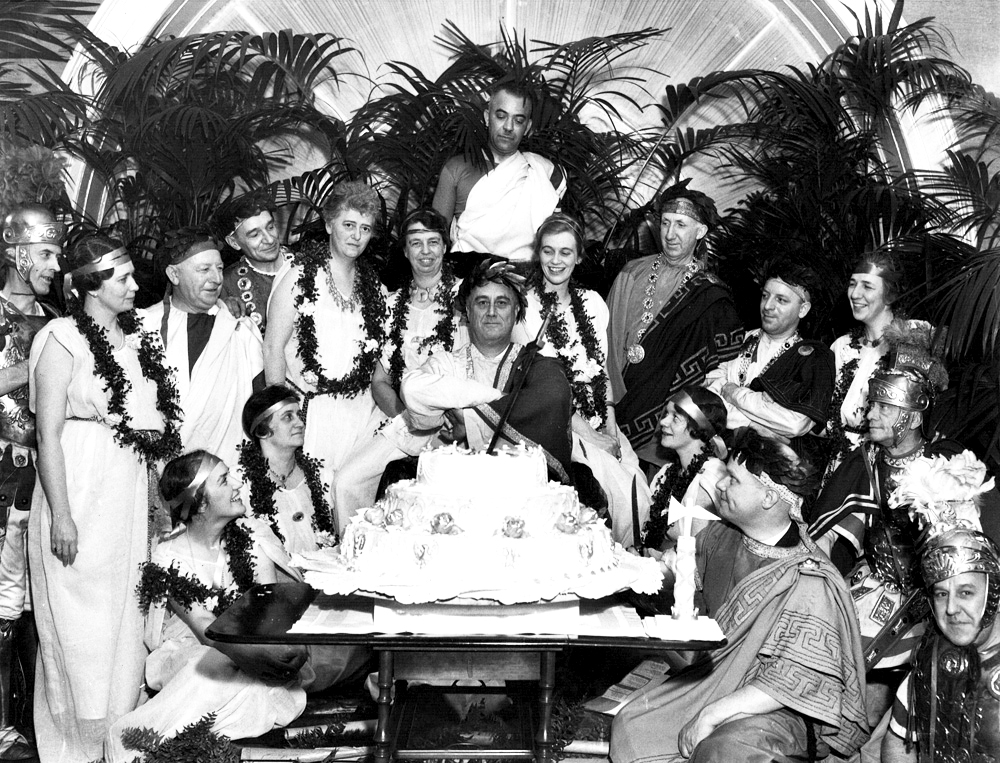 FDR's birthday party, 1934
FDR's birthday party, 1934
FDR Library and MuseumOn January 30, 1934, Roosevelt’s inner circle of friends celebrated his birthday at the White House dressed in Roman togas, poking fun at critics’ claims that the president had dictatorial ambitions. They were not the only ones commemorating Roosevelt’s birthday. In cities and towns across the country, Americans danced, celebrated, and raised over $1 million for the President’s Birthday Ball to Combat Infantile Paralysis. At each of the numerous events, 70 percent of the proceeds went to local polio treatment and relief, while the remainder helped fund the Warm Springs Foundation.
The Birthday Ball immediately became an annual event. Beginning in 1935, the President’s Birthday Ball Commission for Infantile Paralysis Research mobilized to “wipe out the disease itself” on a national scale. Ahead of that year’s Ball, Roosevelt named Paul de Kruif (AAI 1921) secretary of the Commission and tasked him with the responsibility of determining how to distribute the 30 percent of proceeds not retained for local care. They wanted a cure, not just treatment.
The March of Dimes
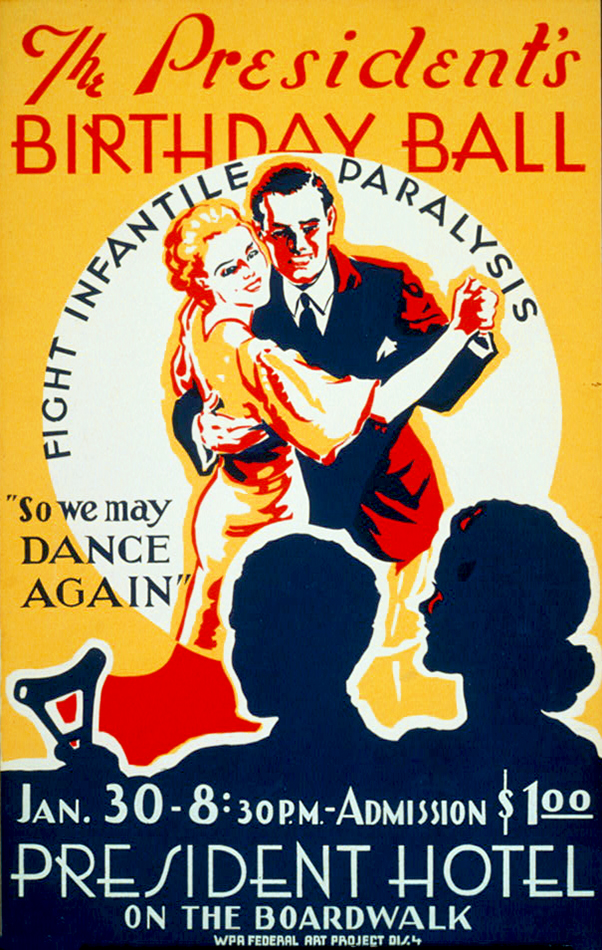 FDR's Birthday Ball, 1939
FDR's Birthday Ball, 1939
Library of CongressThree years later, Roosevelt reorganized the Commission into the National Foundation for Infantile Paralysis (NFIP). The popular comedian and singer Eddie Cantor told radio listeners to send “a march of dimes all the way to the White House,” and Americans responded by mailing in 80,000 dimes in addition to the $1.5 million collected for the 1938 Birthday Ball. Contributions kept climbing: in 1945 the March of Dimes raised nearly $19 million. Like donations, however, cases of polio were steadily increasing.
Treatment and Research
Polio was the second-most researched human virus worldwide from 1935 to 1960, only exceeded by influenza. In 1937, Edwin Both invented a much less expensive respirator that could be produced easily and rapidly. The newly available technology increased survival rates significantly but could do nothing to prevent long-term paralysis.
The War Years
When the United States entered the Second World War, research on primarily childhood diseases like polio was deprioritized in favor of diseases that would affect military readiness at training bases in the United States or fighting overseas.
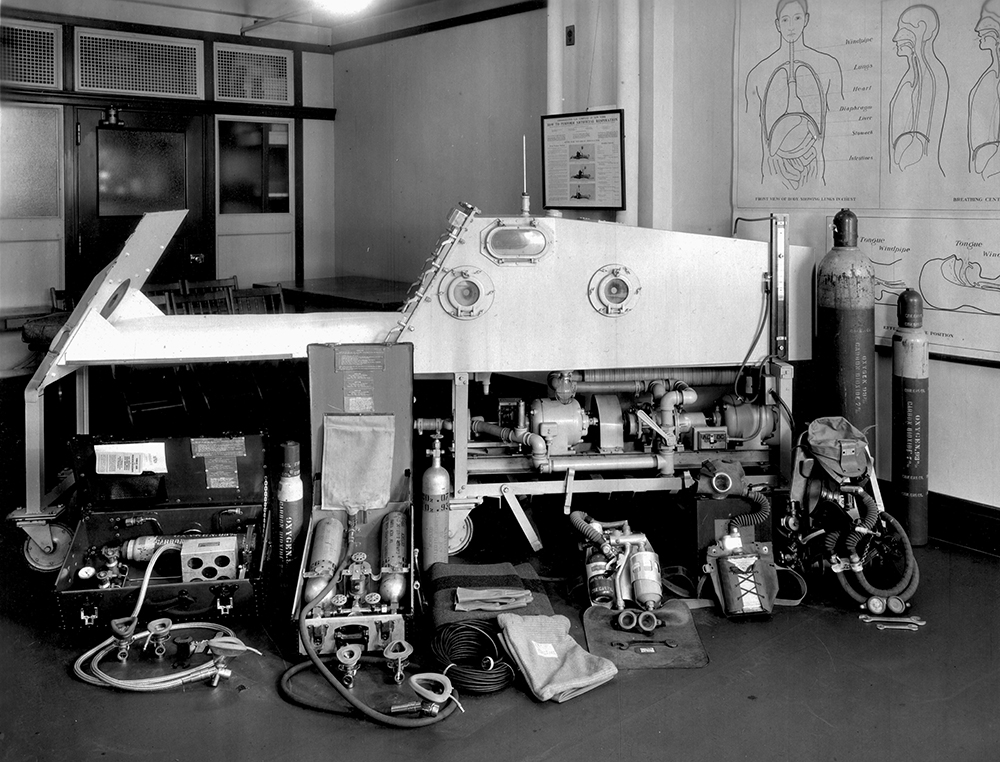 Drinker Respirator, ca. 1930
Drinker Respirator, ca. 1930
Harvard Medical School LibraryIn Boston, a little-known assistant professor at Harvard Medical School (HMS) was encouraged to direct his research toward mumps for the war effort. Because other more established researchers were working on the major warrelated diseases, such as influenza, typhus, and yellow fever, there was little room (or funding) remaining for John F. Enders (AAI 1936, president 1952–53), so he began a new study on mumps. This seemingly small choice of switching to non-clinical, in vitro mumps research would yield significant discoveries about the disease and, within a decade, also break the logjam that had prevented progress in polio research.
On the home front during the war, the number of polio cases continued to climb each year, from 4,033 in 1942 to 12,449 the next year, and to 19,029—with 1,433 deaths—in 1944. The Journal of Immunology (The JI) published a few articles on polio over the course of the war, most of them by S. D. Kramer at the Michigan Department of Health. Kramer had been prolific in polio research from the late 1930s, demonstrating in 1939 that the poliovirus could be found in the stools of apparently healthy carriers. Supported by grants from the NFIP, Kramer was able to continue working on polio through the war, publishing research on the production of immunity in mouse models.
A New Understanding of Poliovirus
A dramatic rise in polio case numbers following the end of the war led to a major resurgence in polio research. Widespread use of the iron lung was saving many children from death, but also leaving increasing numbers with chronic disabilities. With the war over, researchers were free to focus on this new rising threat. Joseph L. Melnick (AAI 1948), who would later become a titan in polio research, was one of the first to publish on polio in The JI in peacetime. In 1946, he had been working on novel applications of the ultracentrifuge to isolate the poliovirus from monkey stool. The proliferation of the virus in the gastrointestinal tract inspired Melnick’s later classification of the group of enteroviruses, with the poliovirus as its prototype.
John F. Enders
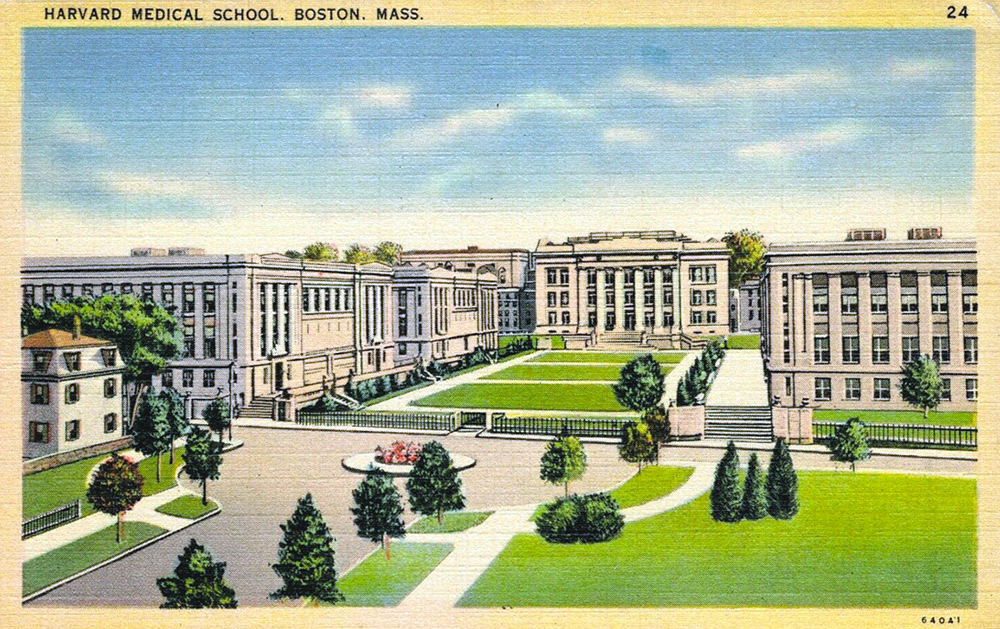 Harvard Medical School campus, ca. 1941All research on a polio vaccine to that point had been performed without the ability to culture the poliovirus. For any experiment on polio, the virus had to be isolated and purified from monkeys, which increased the time and cost involved in the process. It was also widely accepted that the virus would only grow in nervous tissue, which was difficult to culture and grow in vitro. Three researchers at HMS, led by Enders, made the key discovery that would lead to effective vaccines not only for polio but also for a range of other common viral diseases.
Harvard Medical School campus, ca. 1941All research on a polio vaccine to that point had been performed without the ability to culture the poliovirus. For any experiment on polio, the virus had to be isolated and purified from monkeys, which increased the time and cost involved in the process. It was also widely accepted that the virus would only grow in nervous tissue, which was difficult to culture and grow in vitro. Three researchers at HMS, led by Enders, made the key discovery that would lead to effective vaccines not only for polio but also for a range of other common viral diseases.
John F. Enders had a unique background among his peers at HMS. He was classically trained in English literature, including research in Celtic and Teutonic language, having earned an A.B. and M.A. in the field. He was working on a Ph.D. with the goal of becoming an English teacher before a chance encounter with Hans Zinsser (AAI 1917, president 1919–20), professor of bacteriology and immunology at HMS. In 1925, Enders accompanied a friend from his boarding house, Hugh Ward, who was an instructor in Zinsser’s department, to the laboratory as he changed some media in bacteria cultures. Enders later wrote that “[Zinsser and I] soon became friends, and thus I fell into the habit of going to the laboratory with him in the evening and watching him work. I became increasingly fascinated by the subject—which manifestly gave him so much pleasure and about which he talked with such enthusiasm—and so eventually decided to change the direction of my studies.”
Virus Research
Enders soon switched from a Ph.D. in English to one in bacteriology and immunology (which was unusual because at the time an M.D. was more common for both clinical and basic researchers in the field). He then spent the next 15 years working with Zinsser. His first faculty appointment came at the age of 32. Initially his research focused on immune responses to bacteria, but in 1937 he made the move to viruses.
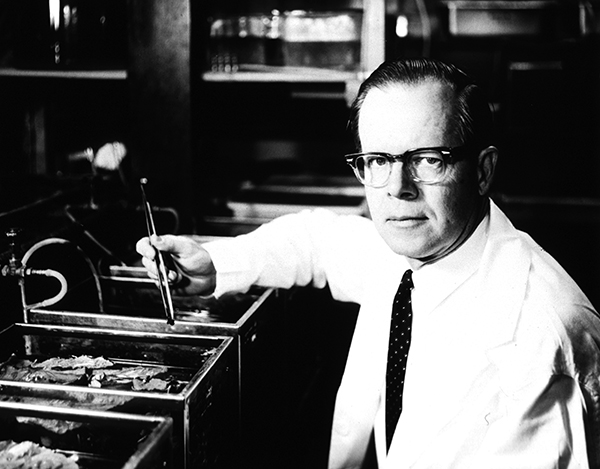 Thomas H. Weller, 1968
Thomas H. Weller, 1968
National Library of MedicineEnders began his virus research while working with William McD. Hammon (AAI 1946) on a usually fatal disease in kittens known as panleukopenia, also known as cat distemper or enteritis. Enders and Hammon identified the virus that causes the disease and demonstrated that the virus initially infects the bone marrow. They created a vaccine that quickly became the standard in veterinary care.
Enders also began research on the growth of the herpes simplex virus, assisted by then fourth-year medical student Thomas Weller (AAI 1943). Their initial work on the tissue-culture method was interrupted by the outbreak of the Second World War, when Weller left to serve as head of the Departments of Bacteriology, Virology, and Parasitology at the U.S. Army Antilles Medical Laboratory in Puerto Rico.
The New Enders Lab
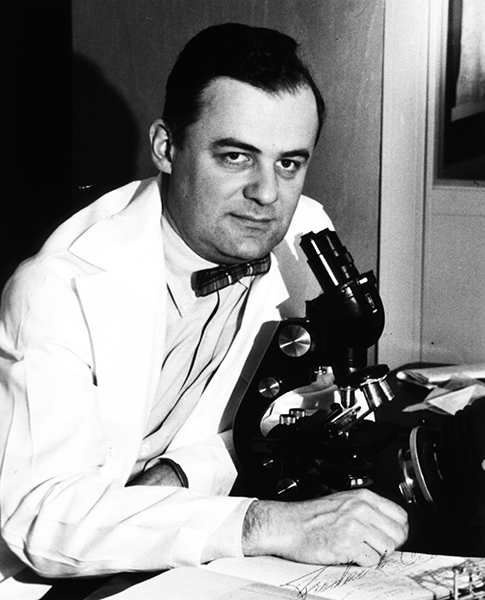 Frederick C. Robbins, 1955
Frederick C. Robbins, 1955
National Library of MedicineIn 1947, the Boston Children’s Hospital asked Enders to establish an infectious disease laboratory, which would be partially funded through a five-year basic viral research NFIP grant to HMS. Enders and Weller were soon joined by the third member of their team, Frederick C. Robbins (AAI 1952), who had been the chief of the Viral and Rickettsial Disease Section of the Fifteenth Medical General Laboratory of the U.S. Army, serving in North Africa and Italy.
Initially, all their research was viral, but none of it was on polio. Enders continued his mumps research, while Weller went to work on chicken pox and Robbins on the viral cause of infant epidemic diarrhea. All three, however, were working on in vitro cultivation to grow their viruses.
In 1948, Enders and Weller developed the first successful method for growing the mumps virus in vitro using a culture of mainly chicken-embryo fragments and ox blood. Weller then took that method and attempted to grow the chicken pox virus in vitro with embryonic human muscle and skin as the culture, with the addition of a combination of penicillin and streptomycin to eliminate bacterial contamination. Importantly, Weller discovered that if the nutrient media was changed at regular intervals, the tissue would live longer, thus allowing more time for the virus to propagate.
The Breakthrough
Having some leftover culture flasks from his chicken pox experiment, and at Enders’s suggestion, Weller added some of the Lansing Type II poliovirus they had in the laboratory’s freezer. At the same time, Robbins was readying his cultures for experiments to identify viruses responsible for infant diarrhea using mouse intestines and used the Lansing strain in a few of his flasks. Poliovirus grew successfully in Weller’s cultures; it did not in Robbins’s. Weller’s successful experiment led the team to quickly refocus all their research on growing poliovirus in vitro.
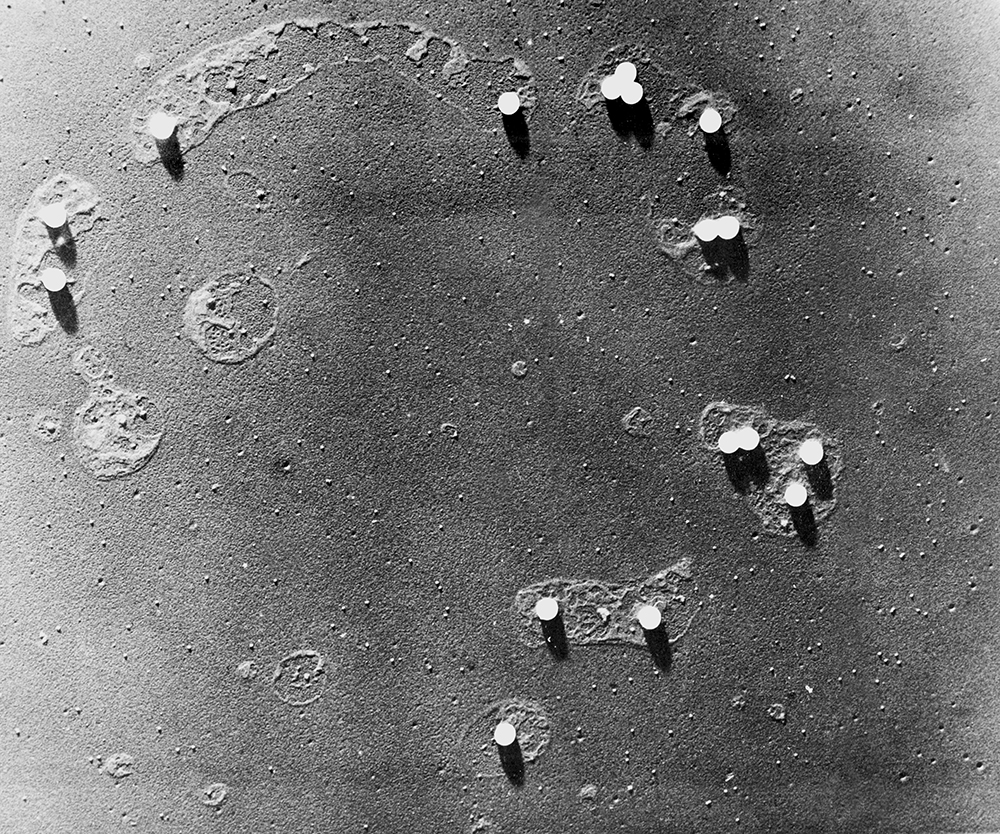 SEM image of polio virus
SEM image of polio virus
CDCTo that point, polio was still considered primarily a disease of the nervous system. But the composition of Weller’s culture, combined with the abundance of recent research showing that poliovirus was found in the gastrointestinal tract of humans, inspired the three scientists to attempt to culture it in non-nerve human embryonic tissue, including intestine. The team successfully cultured all three strains of poliovirus, opening up the possibility of in vitro studies of the virus and enabling rapid development of effective vaccines. Expensive monkeys—and the risks involved with maintaining a population of infected animals—were no longer necessary to produce the virus for research. Their technique also led to the isolation of several other viruses and the development of corresponding vaccines: measles, rubella, mumps, herpes simplex, and herpes zoster. Their research was published in a three-part series in the December 1, 1952, issue of The JI.
Nobel Prize
The trio received the Nobel Prize for “their discovery of the ability of poliomyelitis viruses to grow in cultures of various types of tissue" in 1954 after some controversy in the Nobel committee. Enders had first been nominated individually in 1952. Sven Gard, the chair of virology at the Karolinska Institut, had long been involved in polio research and evaluated the nomination favorably but expressed reservations about awarding the Prize to Enders alone. The next year, John Dingle (AAI 1941, president 1957–58) nominated Enders along with Weller and Robbins, but the nomination was not advanced. In 1954, the Nobel Committee received nine nominations for Enders, two of which included Weller and Robbins.
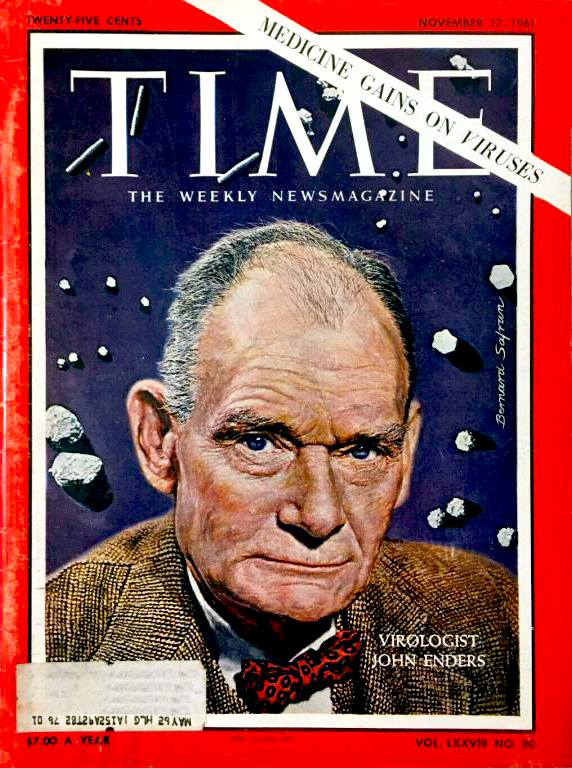 John F. Enders, Time, Nov. 17, 1961
John F. Enders, Time, Nov. 17, 1961
Time magazineThis time, Gard was determined that the Nobel Prize go to the scientists who had unlocked the mystery of polio. The Nobel Committee initially recommended Vincent du Vigneaud as the laureate, but Gard enthusiastically pushed the Nobel Assembly at Karolinska Institut, the body responsible for the final decision for the Prize in Physiology or Medicine, not to follow the recommendation of the Committee and instead select Enders, Weller, and Robbins. The Assembly accepted Gard’s arguments and awarded the team the Nobel in 1954. News of the unusual behind-the-scenes dispute was leaked to the New York Times, but du Vigneaud received some consolation when he was given the Nobel Prize in Chemistry the very next year.
Even as Nobel Laureates, Enders, Weller, and Robbins are not familiar names like Salk or Sabin are today because their work was not as public facing as the vaccine creators’. Nevertheless, their discovery came at a crucial time when polio was affecting more children than ever before.
Toward a Vaccine
In the fall of 1949, Jonas Salk (AAI 1947), the nearly 39-year-old director of the Virus Research Laboratory at the University of Pittsburgh School of Medicine, wrote to Enders requesting a sample of a successful culture material for growing poliovirus. Salk, searching for a faster way to produce a killed virus vaccine, was deferential to Enders, stating that he did “not want to intrude on any things you might be doing or want to do…if you have already made plans to do any studies of this sort on your own.” Enders initially turned down Salk’s request as they were conducting some preliminary studies toward a vaccine.
Unbeknownst to Salk, Enders and his two younger colleagues were at odds about the next step of their research. Enders viewed vaccine research as beneath basic researchers, and a problem more suited for industry to undertake. Furthermore, he recognized that their relatively new lab was “not set up for vaccine production.” As head of the lab, Enders’s argument won the day and samples of and techniques for tissue culture were shared with Salk. The race toward a successful vaccine was gaining speed.
In the July issue of the AAI Newsletter, we will cover the application of this basic research to the development of successful polio vaccines and the legacy of the national drive to defeat an epidemic disease.
See also articles that were part of this series:
References
- Doherty, Henry L. “Another Roosevelt Birthday Ball to Combat Infantile Paralysis.” Sun-Sentinel (Charleston, MS). 13 December 1934.
- Dauer, C. C. “Incidence of Poliomyelitis in 1947.” Public Health Reports 63, no. 13.
- Enders, John F. “General Preface to Studies on the Cultivation of Poliomyelitis Viruses in Tissue Culture.” The Journal of Immunology 69, no 6: 639–43.
- Enders, John F. , Frederick C. Robbins, and Thomas H. Weller. “Cultivation of the Lansing Strain of Poliomyelitis Virus in Cultures of Various Human Embryonic Tissues Science.” Science 109, no. 2822.
- Enders, John F. , Frederick C. Robbins, and Thomas H. Weller. “The Cultivation of the Poliomyelitis Viruses in Tissue Culture.” Nobel Lecture. 11 December 1954.
- Eyler, John M. “De Kruif’s Boast: Vaccine Trials and the Construction of a Virus.” Bulletin of the History of Medicine 80, no. 3.
- Kramer, S. D. “The Development of Active Immunity in Swiss Mice with Infective and Non-Infective Suspensions of Poliomyelitis Virus.” The Journal of Immunology 50, no. 5, 275–81.
- Kramer, S. D. “Recovery of the Virus of Poliomyelitis from the Stools of Healthy Contacts in an Institutional Outbreak.” Public Health Reports 54, no. 43.
- Melnick, Joseph L. “My Role in the Discovery and Classification of the Enteroviruses.” Annual Review of Microbiology 50.
- Melnick, Joseph L. “The Recovery of Poliomyelitis Virus from the Stools of Experimentally Infected Monkeys and Chimpanzees.” The Journal of Immunology 53, no. 3, 277–90.
- Norrby, Erling. “Polio and Nobel Prizes: Looking Back 50 Years.” Annals of Neurology 61
- Oshinsky, David H. Polio: An American Story. New York: Oxford, 2005.
- Robbins, Frederick C., Thomas H. Weller, and John F. Enders, “Studies on the Cultivation of Poliomyelitis Viruses in Tissue Culture II. The Propagation of the Poliomyelitis Viruses in Roller-Tube Cultures of Various Human Tissues.” The Journal of Immunology 69, no 6: 673–94.
- Weller, Thomas H., John F. Enders, Frederick C. Robbins, and Marguerite B. Stoddard. “Studies on the Cultivation of Poliomyelitis Viruses in Tissue Culture I. The Propagation of Poliomyelitis Viruses in Suspended Cell Cultures of Various Human Tissues.” The Journal of Immunology 69, no 6: 645–71.
- Weller, Thomas H. and Frederick C. Robbins “John Franklin Enders, 1897–1985.” in Biographical Memoirs: Volume 60 Washington, DC: National Academy of Sciences Press, 1991.
- Williams, Greer. Virus Hunters. New York: Alfred A. Knopf, 1959.
- “F.D.R. Birthday Balls Bring in $1,500,000.” Akron Beacon Journal. 15 March 1938.
- “From the Museum: Marion Dickerman’s Toga Costume.” Franklin D. Roosevelt Presidential Library and Museum, https://fdr.blogs.archives.gov/2012/01/24/from-the-museum-30 (last updated January 24, 2012)
- “Plans Are Started to Form Committees for Presidential Ball to Be Held in January.” Argus-Leader (Sioux Falls, SD). 30 December 1934.
- “Scribes and Scrips.” Morning Post (Camden, NJ). 29 December 1934.